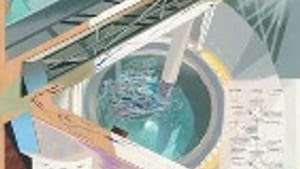Stay in the Loop
BSR publishes on a weekly schedule, with an email newsletter every Wednesday and Thursday morning. There’s no paywall, and subscribing is always free.
Ellen Levy's 'Public Secrets'

Don't blame Donald Rumsfeld
ROBERT ZALLER
Political art comes in all styles. There’s the in-your-face kind pioneered by Goya, raw with atrocity. There’s the stance of a neutral-seeming observer like Jacques Callot, meticulously rendering the bunched bodies of peasants hanged on trees. There are the Weimar painters— Beckmann, Dix, Grosz— with their postwar grotesques. Picasso on Franco; Guston on Nixon. Coming right up to date, Botero’s recent series on Abu Ghraib.
Ellen K. Levy takes a more nuanced position in the important recent show at the Michael Steinberg Gallery in New York’s Chelsea. Levy’s interest is in the intersection between corporate and military technology and the environment. She possesses a connoisseur’s appreciation for the bland precision of technical drawings and patent applications, for the gleam of tubing and the glow of reactor rods, and an understated but deeply moral response to the indifferent ease with which we now appropriate our delicate and beautiful planet, experimenting on it like the cadaver it may well soon become under our ministrations.
Some futurists love warfare
What Levy opposes to this is an artistic and historical sensibility that’s subversive of the material it depicts while keenly interrogating the often naïve aesthetic response of 20th-Century art to modern technology. We tend to forget the enthusiasm with which the Italian Futurists greeted the age of mass warfare, or the Russian Constructivists the advent of modern industry. Levy’s poster-like collages wittily reference the turbines of early Picabia and the tubular forms of Leger, even while she conducts us through a Dantesque underworld of secret laboratories and survival shelters beneath a fractured earth.
Sleek, shark-like blues predominate in many of Levy’s current works, and her palette is generally muted and cool, though there are many expressive touches and passages that display her powerful, painterly imagination. The flat planes of the picture surface make the kinetic agitation that roils it all the more disturbing, though there is also a sense of mock detachment, both mirroring the technological mindset that is the ultimate subject of the work itself and Levy’s own quest for critical perspective on it.
Our scientific hubris
A series of unframed scrolls exhibits an almost Japanese formality, even as their jaggedly descending forms— paper edges, window fragments, ice floes?— suggest a world spinning recklessly out of control. As the very titles of her work suggest—“Mounting a Sky Turbine on a City,” “Altering the Magnetosphere (N. Tesla)”— our scientific hubris is violently altering both the human and natural environment, asserting a dominion that, in a society dominated by a military-industrial complex far more penetrating and sophisticated than in Eisenhower’s day, threatens us not merely with the nuclear calamity of old but reaches down into the genetic code itself.
The special value of Levy’s art for us, however, is that it refuses to settle for any facile separation of Us and Them, but suggests a general cultural complicity in which we’re all implicated, her own art colleagues and precursors not excepted— and, for that matter, Levy herself. The rigor and honesty of Levy’s own self-criticism, of her own fascination with the topsy-turvy world she depicts, compels equal honesty from the viewer. It is not merely a Faust, a Victor Frankenstein, or a Donald Rumsfeld who is responsible for this. Levy’s art is a mirror in which, if we look deeply enough, we will also find ourselves.
ROBERT ZALLER
Political art comes in all styles. There’s the in-your-face kind pioneered by Goya, raw with atrocity. There’s the stance of a neutral-seeming observer like Jacques Callot, meticulously rendering the bunched bodies of peasants hanged on trees. There are the Weimar painters— Beckmann, Dix, Grosz— with their postwar grotesques. Picasso on Franco; Guston on Nixon. Coming right up to date, Botero’s recent series on Abu Ghraib.
Ellen K. Levy takes a more nuanced position in the important recent show at the Michael Steinberg Gallery in New York’s Chelsea. Levy’s interest is in the intersection between corporate and military technology and the environment. She possesses a connoisseur’s appreciation for the bland precision of technical drawings and patent applications, for the gleam of tubing and the glow of reactor rods, and an understated but deeply moral response to the indifferent ease with which we now appropriate our delicate and beautiful planet, experimenting on it like the cadaver it may well soon become under our ministrations.
Some futurists love warfare
What Levy opposes to this is an artistic and historical sensibility that’s subversive of the material it depicts while keenly interrogating the often naïve aesthetic response of 20th-Century art to modern technology. We tend to forget the enthusiasm with which the Italian Futurists greeted the age of mass warfare, or the Russian Constructivists the advent of modern industry. Levy’s poster-like collages wittily reference the turbines of early Picabia and the tubular forms of Leger, even while she conducts us through a Dantesque underworld of secret laboratories and survival shelters beneath a fractured earth.
Sleek, shark-like blues predominate in many of Levy’s current works, and her palette is generally muted and cool, though there are many expressive touches and passages that display her powerful, painterly imagination. The flat planes of the picture surface make the kinetic agitation that roils it all the more disturbing, though there is also a sense of mock detachment, both mirroring the technological mindset that is the ultimate subject of the work itself and Levy’s own quest for critical perspective on it.
Our scientific hubris
A series of unframed scrolls exhibits an almost Japanese formality, even as their jaggedly descending forms— paper edges, window fragments, ice floes?— suggest a world spinning recklessly out of control. As the very titles of her work suggest—“Mounting a Sky Turbine on a City,” “Altering the Magnetosphere (N. Tesla)”— our scientific hubris is violently altering both the human and natural environment, asserting a dominion that, in a society dominated by a military-industrial complex far more penetrating and sophisticated than in Eisenhower’s day, threatens us not merely with the nuclear calamity of old but reaches down into the genetic code itself.
The special value of Levy’s art for us, however, is that it refuses to settle for any facile separation of Us and Them, but suggests a general cultural complicity in which we’re all implicated, her own art colleagues and precursors not excepted— and, for that matter, Levy herself. The rigor and honesty of Levy’s own self-criticism, of her own fascination with the topsy-turvy world she depicts, compels equal honesty from the viewer. It is not merely a Faust, a Victor Frankenstein, or a Donald Rumsfeld who is responsible for this. Levy’s art is a mirror in which, if we look deeply enough, we will also find ourselves.
Sign up for our newsletter
All of the week's new articles, all in one place. Sign up for the free weekly BSR newsletters, and don't miss a conversation.

 Robert Zaller
Robert Zaller